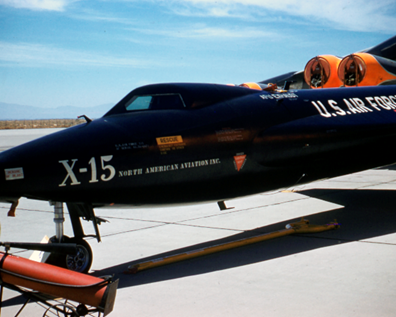A number of aspects of the joint U.S. Air Force, National Aeronautics and Space Administration and U.S. Navy X-15 flight research project that began in 1958 had an impact on the development of several technologies used in Project Apollo. In particular, it influenced both the Lunar Landing Research Vehicle (LLRV) and Lunar Landing Training Vehicle (LLTV), which used the same hydrogen peroxide rockets utilized in the X-15. In addition, the materials developed for the X-15, such as titanium and nickel-steel alloys, also proved valuable for the design of the Apollo and later spacecraft. Finally, the development of a bi-metallic “floating retainer” to dissipate stresses in the X-15's windshield also came into use in the windshields of the Apollo capsule.
On Feb. 10, 1961, Rocketdyne engineers at the rocket test facility atop Leuhman Ridge at Edwards Air Force Base conducted the first captive firing of the F-1 Saturn rocket engine. The F-1’s prototype thrust chamber produced 1.55 million pounds of thrust within a few seconds. The Saturn constituted the launch vehicle for Project Apollo and the lunar landing mission.
An experimental prototype developed to explore the concept of returning Gemini and Apollo spacecraft to Earth using a hang glider-type wing, the Paraglider Research Vehicle (Paresev), underwent test in a first flight by NASA research pilot Milton O. “Milt” Thompson on Feb. 12, 1962. The unpowered, open-framework fuselage grew out of a 1960s NASA Langley concept, and seemed a way to return a spacecraft to Earth via landing vice a splashdown. The cost and logistics finally proved unworkable, but the Paresev flight research program completed 350 flights between 1962 and 1964, revolutionized hang-gliding, and contributed to the development of some concepts worked out in the X-38.
The 6511th Test Group (Parachute) stationed at Edwards successfully dropped a full sized test module of the Apollo manned spacecraft from a modified C-133 at El Centro on May 1, 1963. This constituted the first test of an Apollo earth landing system, although  ultimately NASA chose to use the splashdown method.
ultimately NASA chose to use the splashdown method.
One quite significant contribution to NASA’s lunar landing effort, and one influenced by the X-15 project, began at what is now the NASA Armstrong Flight Research Center on Oct. 30, 1964, when NASA research pilot Joe Walker made the first flight of Bell’s LLRV. The NASA Flight Research Center developed the LLRV, nicknamed the “Flying Bedstead,” to simulate a lunar landing profile for research and lunar pilot training for NASA’s Apollo program. The angular structure came equipped with a small jet engine, two lift rocket motors, and 16 smaller rockets to provide flight control, powered by hydrogen peroxide. The LLRVs led to development of three LLTVs used to train astronauts at the Manned Spacecraft Center in Houston, Texas. Neil Armstrong credited the success of the lunar landing to the simulations and training provided by the LLRV and the LLTV.
An EC-135N high altitude communications relay station aircraft arrived at the Air Force Test Center (then called the Air Force Flight Test Center) for evaluation on Oct. 6, 1966. The aircraft, modified with a 10-foot nose radome, constituted the first of eight planned Apollo Range Instrumented Aircraft (ARIA) for use as a flying world-wide communications network for the Apollo program. This function, renamed the Advance Range Instrumentation Aircraft, persisted after the Apollo program ended.
History In Two PDF